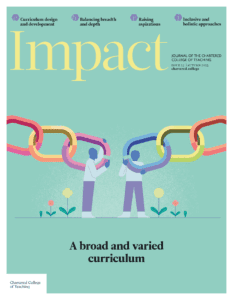It’s alternative provision, not lesser provision: A critical reflection on the English curriculum for students in alternative provision

STEPHANIE POVEY, ASSISTANT HEADTEACHER IN CHARGE OF QUALITY OF EDUCATION, THE EDGE ACADEMY, UK
In a system where too many young people are not meeting the required standard of a grade 4 in GCSE English language (Martin, 2023), it is important to explore those students left behind and to understand their curriculum offer. This issue extends beyond the GCSE years and into the post-16 phase of education, with an increasing number of young people having to resit English language and repeatedly failing to meet the grade 4 standard (Camden, 2023). This coincides with the rate of young people not in education, employment or training (NEET) increasing to 13.2 per cent in 2023 (DfEDepartment for Education - a ministerial department responsible for children’s services and education in England, 2025b). In alternative provision (AP) settings, we see these issues amplified: Department for EducationThe ministerial department responsible for children’s services and education in England data for 2023/24 shows that the pass rate in English Language and Literature examinations was only 14 per cent for students who attended an AP at their final point of GCSE, compared to 72 per cent for mainstream students (DfE, 2025a). This piece reflects on changes made within English in an AP to challenge low expectations and to best support the young people who arguably need it the most.
Trauma-informed practice ‘acknowledges the need to see beyond an individual’s presenting behaviours and to ask, “What does this person need?” rather than “What is wrong with this person?”’ (Office for Health Improvement & Disparities, 2022). The traumas that AP students have experienced take a variety of forms, from children in care or experiencing poverty, to those with severe SEND (special educational needs and disabilities), to those that come from a family that, for multiple generations, has had a poor experience of the education system.
OfstedThe Office for Standards in Education, Children’s Services and Skills – a non-ministerial department responsible for inspecting and regulating services that care for children and young people, and services providing education and skills (2024) has noted that alternative provision is variable, with many schools being unregistered. Their review describes how placements can break down, resulting in students having a ‘fragmented education’ with ‘multiple placement breakdowns’ and ‘delays in children receiving the right support’ because of poor communication between home, schools and AP settings. For students who are already behind, receiving worse provision than their mainstream counterparts offers them almost no pathway to success.
In my time as an AP teacher of English, I have encountered schools that narrow the curriculum, making English literature optional or even replacing both English courses with a functional skills course in an attempt to meet the requirements for post-16 courses. In approaching AP with a deficit lens, students’ experiences are diminished and their negative feelings towards school can be reinforced, compounding existing issues.
Instead, there is benefit in considering what can be added to the experience for students who need as many pathways of support as possible. Instead of removing students from English literature GCSE, for example, students should have their experience supplemented with functional skills qualifications where appropriate. The best-case scenario for these students is that they achieve three English qualifications, creating a passport to post-16 education. The worst case is that they have been exposed to a range of approaches that will support their transition to resits, increasing their chances of passing earlier rather than having to endure repeated cycles of entry and potential consequential failure (Lupton et al., 2021) in a system that is not tailored to their needs (Crisp et al., 2023).
In an AP, curriculum content must be presented to engage students who are disaffected due to their past struggles, while making it accessible to those who are behind where they should be, often in a compressed timescale compared to mainstream teaching. With considered exam specification choices, teachers can carefully interweave content and skills to encourage progress in both English and English literature. Combining interleavingAn approach to learning where, rather than focusing on one piece of content at a time (known as blocking) then moving on to the next, students alternate between related concepts and spaced learning means that students regularly revisit the content of texts, but they also get to apply knowledge in different contexts, which is especially helpful with the unseen nature of GCSE texts (Perry et al., 2021).
Perhaps most key is the way in which the English subject curriculum is anchored: interleaving different texts together using concepts – which we refer to as ‘Big Ideas’ – looking at what the writers are trying to say about the world, before tackling more technical aspects (AQA, 2014). This makes approaching the challenging texts of the GCSE literature and language more accessible and caters to students’ needs. They can also start to feel much-needed success in a subject where they may have previously struggled.
Take, for example, the poem ‘London’ by William Blake. While its ABAB rhyme scheme may be familiar to a student with good attendance who has been exposed to poetry consistently, it is inaccessible to a student with more sporadic experience, who may also be overwhelmed by the challenging vocabulary. Focusing instead on Blake’s key message of a call for revolution against the corrupt Church, with the ABAB rhyme scheme recalling a walk through a city, the march of a revolutionary army or even a heartbeat, can engage rather than alienate the student.
A top-down approach also highlights the connections between poems, such as Shelley’s attack on the monarchy in ‘Ozymandias’; bracketing the poems under the concept of ‘power and authority’ and introducing them through the concept of challenging those in charge offers students a starting point from which to build their own interpretation of the text and evaluate how effectively the poets have presented their message.
Students in AP need a considered and balanced experience of school to address, rather than shy away from, the challenges that they will have already faced. Students in AP are the most likely to become NEET, reducing their life chances. Curriculum for AP should offer sufficient challenge and be trauma-informed, to facilitate high-quality teaching and learning for students who, traditionally, have struggled in education; it is an alternative curriculum provision, and not a lesser one.
- AQA (2014) GCSE English literature specimen mark scheme Paper 1.
- Camden B (2023) GCSE resits 2023: Maths and English pass rates down again. FE Week, 24 August, 23. Available at: https://feweek.co.uk/gcse-resits-2023-maths-and-english-pass-rates-down-again (accessed 22 April 2025).
- Crisp B, Hallgarten J, Joshua V et al. (2023) Post-16 GCSE resit practice review. Education Endowment Foundation. Available at: https://educationendowmentfoundation.org.uk/education-evidence/evidence-reviews/post-16-practice-review (accessed 21 July 2025).
- Department for Education (DfE) (2025a). Academic year 2023/24: Key stage 4 performance. Available at: explore-education-statistics.service.gov.uk/find-statistics/key-stage-4-performance/2023-24 (accessed 25 September 2025).
- Department for Education (DfE) (2025b) NEET age 16 to 24: Calendar year 2024. Available at: https://explore-education-statistics.service.gov.uk/find-statistics/neet-statistics-annual-brief/2024#dataBlock-bff17f1b-9921-4bbc-9f49-992bef91750e-tables (accessed 22 April 2025).
- Lupton R, Thomson S, Velthuis S et al. (2021) Moving on from initial GCSE ‘failure’: Post-16 transitions for ‘lower attainers’ and why the English education system must do better. Nuffield Foundation. Available at: www.nuffieldfoundation.org/wp-content/uploads/2021/02/Post16-transitions-for-lower-attainers-Final-report.pdf (accessed 21 July 2025).
- Martin M (2023) GCSE results 2023: Results by subject. TES Magazine, 24 August, 23. Available at: www.tes.com/magazine/news/secondary/gcse-results-2023-by-subject (accessed 22 April 2025).
- Office for Health Improvement & Disparities (2022) Working definition of trauma-informed practice. Available at: www.gov.uk/government/publications/working-definition-of-trauma-informed-practice/working-definition-of-trauma-informed-practice (accessed 2 July 2025).
- Ofsted (2024) Alternative provision in local areas in England: A thematic review. Available at: www.gov.uk/government/publications/alternative-provision-in-local-areas-in-england-a-thematic-review/alternative-provision-in-local-areas-in-england-a-thematic-review (accessed 22 April 2025).
- Perry T, Lea R, Rübner Jørgensen C et al. (2021) Cognitive science approaches in the classroom: A review of the evidence. Education Endowment Foundation. Available at: https://d2tic4wvo1iusb.cloudfront.net/production/documents/guidance/Cognitive_science_approaches_in_the_classroom_-_A_review_of_the_evidence.pdf?v=1753029244 (accessed 21 July 2025).










